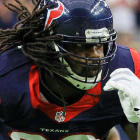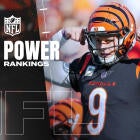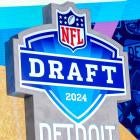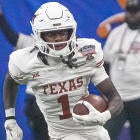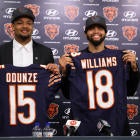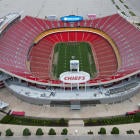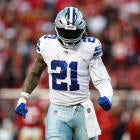The blueprint for defeating the New England Patriots has been the same for years. You're not going to get the better of Tom Brady in a shootout, so the best bet is to make the game as low-scoring as possible and try to eke out a close victory. Doing so generally involves actually slowing down the New England offensive machine, though, and that's obviously easier said than done.
- Who: Houston Texans (9-7) at New England Patriots (14-2)
- When: Saturday, Jan. 14, 8:15 p.m. EST (CBS)
- Where: Gillette Stadium, Foxborough, Mass.
- Latest line: The Patriots are 15-point favorites, according to SportsLine
There is maybe no better example of a team doing this than the Denver Broncos in last year's AFC title game. Von Miller, DeMarcus Ware, Malik Jackson, and Derek Wolfe absolutely owned the game, dominating an undermanned and overwhelmed New England offensive line. The Broncos relentlessly got after Brady all day, ultimately sacking him four times and getting pressure on an incredible 30 of his 61 drop backs, per Pro Football Focus. It took Brady 56 pass attempts to get to 310 passing yards, yielding an average of 5.5 per attempt. He was also intercepted twice.
Brady, like all quarterbacks, sees his performance dip when pressure gets in his face. That's been true throughout his career and it's been true this season as well.
| PRESSURE | COMP | ATT | COMP % | YDS | YPA | TD | INT | RTG |
| NO | 233 | 309 | 75.4% | 2629 | 8.5 | 21 | 0 | 123.0 |
| YES | 58 | 123 | 47.2% | 925 | 7.5 | 7 | 2 | 84.9 |
Brady only saw pressure on 30.9 percent of his drop-backs this season, per PFF, a below-average rate for a quarterback this season. As you can see, though, when pressure did get there, the drop-off in his performance was steep.
The key, though, as the Broncos showed last year, is the ability to generate pressure without having to resort to sending extra rushers with a blitz. Brady annihilates teams that attempt to overwhelm him by using more than four or five rushers to come after him. You simply need to have more men in coverage than that or he'll pick you apart. Case in point:
| BLITZ? | COMP | ATT | COMP % | YDS | YPA | TD | INT | RTG |
| NO | 212 | 312 | 67.9% | 2530 | 8.1 | 14 | 2 | 104.8 |
| YES | 79 | 120 | 65.8% | 1024 | 8.5 | 14 | 0 | 131.4 |
Brady's best skill is his ability to identify the player that's going to come open prior to the snap, then get the ball into that player's hands as quickly as possible. When he does this, blitzes don't have enough time to hit home; and his receivers that catch the ball in stride have that much more room to roam at the second level of the secondary and beyond. Receivers like Julian Edelman and Danny Amendola, and his pass-catchers out of the backfield like James White and Dion Lewis are each adept at creating yards after the catch, but they can't do that without Brady first getting them the ball accurately and on time.
Can the Texans follow the Broncos' blueprint?
The Texans are somewhat well-equipped to replicate the 2015 Broncos' game plan.
The Broncos managed to get their pressure on Brady last year by spreading their defensive line out wider than normal and isolating the offensive linemen in space, giving Miller, Ware, Jackson, and Wolfe as much room to operate as possible. That worked out exactly as planned, as did Denver's strategy of having corners Aqib Talib, Chris Harris Jr., and Bradley Roby play tight coverage close to the line of scrimmage to take away the short, quick crossing patterns the Patriots love to use to get easy yards and move the chains.
The Texans have a stud group of cornerbacks (Johnathan Joseph, Kareem Jackson, and A.J. Bouye) and a strong pass rush, ranking in the top five in PFF's pressure rate. Joseph, Jackson, and Bouye's ability to press up on their marks helped the Texans rank No. 3 in Football Outsiders' DVOA against short passes, and while New England's short passing game is better than most, that trio seems unlikely to get completely overwhelmed by the task. They can at least make things tougher than usual.
The bigger question for the Texans will be whether they can pierce the New England offensive line without resorting to the blitz. They were among the top-five teams in blitzing this season, per PFF, and as mentioned earlier, Brady consistently makes teams play when they send extra rushers.
Jadeveon Clowney and Whitney Mercilus were among the best pass-rushers in the league at their respective positions, and they will prove tough tests for Nate Solder and Marcus Cannon on the offensive line. Clowney has turned into exactly the kind of monster the Texans envisioned when they made him the No. 1 overall pick a few years ago. He was all over the field yet again last week against the Raiders. The Pats can keep Martellus Bennett in as an extra blocker to help against him, but doing so would rob them of one of their best receiving threats down the middle of the field. It's a tough balance to strike.
Romeo Crennel knows how to generate pressure by getting creative with where his rushers come from, and can dial up more than the occasional zone blitz to throw offensive lines into confusion. New England proved capable of handling that style of rush throughout the season, though, and doesn't seem likely to suddenly forget how to block it in the divisional round.
The Texans have a tall task ahead of them -- the tallest of any team remaining in the playoffs. They're massive underdogs for a reason, and it's not just about the relative impotence of their offense. The defense, good as it was throughout this season, is working against long odds as well. Overcoming them will involve replicating a difficult, complicated game plan. We'll find out Saturday if they're up to the task.













